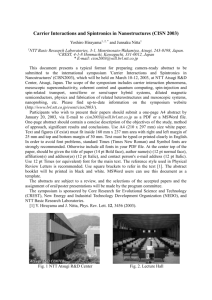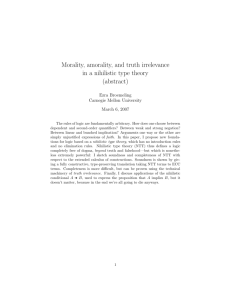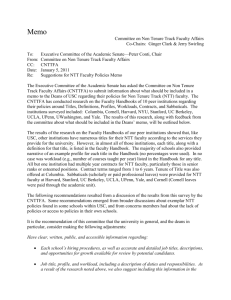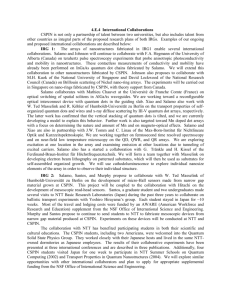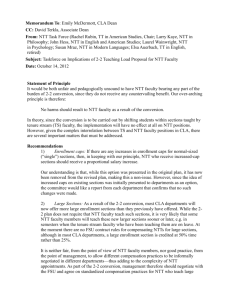Telecommunications Market in Japan
advertisement
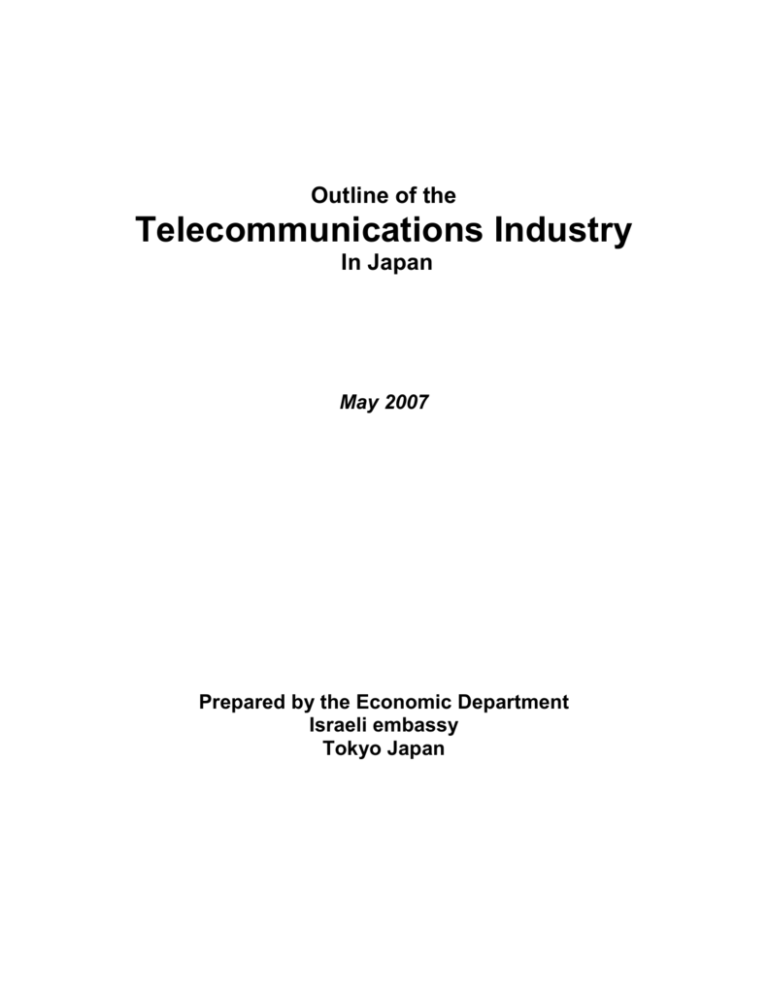
Outline of the Telecommunications Industry In Japan May 2007 Prepared by the Economic Department Israeli embassy Tokyo Japan I. Outline of Japan’s Telecommunications Industry Market Overview The cellular phone market is dominated by three major players: NTT DoCoMo (54.6% of the market), KDDI (28.9%) and Softbank (16.5%). Main Broadband networks in Japan are using DSL, FTTH and CATV. The main players are NTT (NTT East and NTT West), KDDI and Softbank. As of September 2006, NTT has 66% share of the FTTH lines, and announced that by 2010 FTTH installations will exceed 30 million. Internet connection in Japan is characterized by very low prices and high speeds. Monthly charge per bps is still lowest in the world. All major broadband network providers and ISPs provide Triple Play services (Internet connection, IP telephony and IP TV broadcasting). IP Phone services offer attractive prices, and the FTTH network infrastructure become also a battle on ownership of fix line market. As for new technologies, WiMax is being used for business users and is being tested at several places in Japan. In the near future we may expect competition in the broadband network field. In 2006 PLC (Power Line Communication) usage was approved, and is being offered as an alternative to Wi-Fi connection. Short term history: Timeline of Japan’s Telecommunication and Internet Related Business Telecommunication Business in Japan, Telecommunications Bureau Ministry of Public Management, Home Affairs, Posts and Telecommunications Japan ( MPHPT of Japan), July 2004. Until 1985 there was a monopoly on the telecommunication business by two companies, NTT and KDDI, for domestic and international calls respectively. After the Telecommunications Business Law and NTT Law were implemented in April 1985, NTT was privatized and was divided into separate companies by business line and region. On 2000, the rules for unbundling of DSL were introduced. The scale of Japan’s Telecom Industry According to a survey conducted on July 2006 by the Ministry of Internal Affairs and Communications of Japan, the telecommunications sector worth about 16,510 billion yen (approx. 150 billion USD). This figure supports the notion that Japan is the second largest telecommunications equipment market in the world, after the United States. 18,000 16,000 14,000 12,000 10,000 8,000 6,000 4,000 2,000 0 16,72916,761 16,61516,74116,512 15,390 14,222 Fixed phone line Mobile phone 13,238 11,584 9,941 8,239 8,836 10,87710,766 10,67310,434 10,205 10,183 9,328 9,561 5,123 4,595 3,845 Services incidental to telecommunications Total telecommunications market 5,789 5,940 5,884 6,255 6,280 2,683 1,641 49 2004 52 2003 58 2002 56 2001 63 2000 62 1999 66 1998 65 1997 65 1996 64 1995 Nominal Value ( in billion yen) Japanese Telecom Market Year Year Fixed phone line Y-to-Y change (%) Mobile phone Y-to-Y change (%) Services incidental to telecommunications Y-to-Y change (%) Total telecommunications market Y-to-Y change (%) 1995 1996 1997 1998 1999 2000 2001 2002 2003 2004 8,239 8,836 9,328 9,561 10,205 10,877 10,766 10,673 10,434 10,183 1,641 7.3 2,683 63.5 5.6 3,845 43.3 2.5 4,595 19.5 6.7 5,123 11.5 6.6 5,789 13.0 -1.0 5,940 2.6 -0.9 5,884 -0.9 -2.2 6,255 6.3 -2.4 6,280 0.4 64 65 65 66 62 63 56 58 52 49 1.5 -0.4 2.0 -6.9 3.1 -12.4 3.8 -10.8 -4.8 11,584 13,238 14,222 15,390 16,729 16,761 16,615 16,741 16,512 16.5 14.3 7.4 8.2 8.7 0.2 -0.9 0.8 -1.4 9,941 Figure 1.2 Data Source: Ministry of Internal Affairs and Communications Main Players in the Communication Market ■ Competition in the domestic long-distance communications market originally revolved around NTT, KDDI and Japan Telecom. With the advent of broadband services, the main players are now NTT, KDDI, SoftBank, the power companies and CATV. Increasing competition is also expected in the mobile telephone market as new entrants emerge. Produced by MIC from information available on websites Group Own subscriber lines Long distance, international and corporate communication Broadband services Broadcasting and video distribution services Mobile telephony NTT NTT East/West NTT com NTT East/West NTT com Plala Networks 4thMEDIA NTT DoCoMo KDDI KDDI Hikari Plus TV KDDI TEPCO TEPCO casTY K-Opti.com K-Opti.com K-CAT KDDI TEPCO K-Opti.com JCN Group + SoftBank Japan Telecom SoftBank BB BBTV TV Bank Vodafone In future: Vodafone eAccess eAccess Willcom In future: Willcom Willcom J:COM J:COM USEN Yuzu Communications J:COM Media USEN J:COM Gyao Show time All copyrights reserved (MIC) Figure 1.3 Source: www.itu.int/osg/spu/ngn/documents/presentations/seki-23-march-2006.ppt Date of presentation: March 2006 Please note that K-Opticom has already merged with Kansai Electric Power Corporation (KEPCO). And that TEPCO FTTH business was completely acquired by KDDI. II. Mobile Phone Industry Brief history of mobile communications in Japan 1979 1985-1988 1993 1994 1998 1999 2000 2001 2002 NTT Public Corporation provided the 1st automobile phone service (1G) New carriers were introduced in the market NTT DoCoMo begins PDC (2G) New entry continues (PDC) Sale of terminal equipment starts DDIcellular introduces the first CDMA NTT DoCoMo introduces i-Mode (2.5G) Analog transmission for mobile phones was terminated. NTTDoCoMo introduces FOMA on W-CDMA (3G) CDMA2000 competes with W-CDMA (3G competition) Figure 2.1 Data Source: Mobile Communications in Japan, Stanford Japan Center, May 2, 2005 Mobile Services and Utilized Technology Currently, the following are carrier groups that provide mobile phone services, according to area: Mobile Phone Company Technology PDC*(Mova) @ 800MHz and 1.5GHz 3G(FOMA)WCDMA NTT DoCoMo Group KDDI Group SoftBank Group CDMA cdmaOne(800MHz only) CDMA 1X CDMA 1X WIN (PDC @1.5GHz For Tu-Ka) PDC* WCDMA(UMTS 3G) PHS Table 2.2 *PDC – 2G in Japan Data Source: Recent Developments in the Telecommunications industry, Japanese Economy Division, JETRO 2007and Wikipedia. Mobile Phone Carriers Statistics Figure 2.4 Source: NTT DoCoMo, as of Feb 2007 NTT DoCoMo has the biggest share of subscribers in the market followed by KDDI and SoftBank (which has recently acquired Vodafone Japan). Note that Tu-Ka by KDDI services will be stopped in the future and new subscribers are not accepted for this service. Recently two additional players, ipMobile and eMobile received permission to operate as carriers, and we should expect for competition on both voice and data communication services. III. Broadband Networks Internet was introduced in Japan in the early 1980’s. Japan Statistical Yearbook 2007 of MIC, by end of 2005, there are 85.3 million Internet users in Japan, which represent approximately 67% of the population and around 27.3% of Internet subscribers are using broadband networks. Broadband Subscriber ( Fixed Line) 2500 2000 1500 1000 500 Mar01 Sep01 Mar02 Sep02 Mar03 Sep03 Mar04 Sep04 Mar05 Sep05 Mar-06 Nov-05 Jul-05 Mar-05 Nov-04 Jul-04 Mar-04 Nov-03 Jul-03 Mar-03 Nov-02 Jul-02 Mar-02 Nov-01 Jul-01 0 Mar-01 Number of Subscribers ( in 10,000) Wired Broadband Services Mar06 DSL 10 70 240 420 700 920 1120 1280 1370 1430 1450 CATV 80 120 150 180 210 230 260 280 300 310 330 10 30 70 110 200 290 400 550 90 190 390 610 940 FTTH Total 1220 1490 1760 1960 2140 2330 Figure 4.1 Data Source: http://www.ciaj.or.jp/e/japanmarket/index.htm#high Among broadband users, Asynchronous Digital Subscriber Line (ADSL) subscribers still have the largest share, with14.5 million subscribers. However, Fiber-to-the Home (FTTH) that was introduced to the market on 2004 is growing aggressively with almost 8 million subscribers at the end of 2006. It was on 2005, where the increase in the number of FTTH subscribers has surpassed that of the ADSL subscribers. This table shows the connection speed of each service: Wired Broadband Service DSL FTTH CATV Maximum Speed ( in Mbps) 50 100 30 Table 4.2 Source: http://www.ciaj.or.jp/e/japanmarket/index.htm#high DSL Providers BB Technology (subsidiary of SoftBank) has almost the same market share as that of NTT East and West combined. Fiber-to-the-House (FTTH) As of December 31, 2006, there were 7.94 million FTTH subscribers which were about 30.8% of the broadband subscribers as of that time. This diagram shows the major providers of FTTH: NTT East, NTT West and Power companies – TEPCO (FTTH business is now a part of KDDI) and KOpticom (now a part of KEPCO) has the most numbers of FTTH subscribers. Mobile Phone Broadband Services Number of Subscribers ( in 10,000) Mobile Phone Internet Subscriber 1000 500 0 2002 2003 2004 2005 2006 i-mode 355 403 431 456 472 Ezw eb 115 147 175 198 225 Yahoo!Keitai 113 128 130 128 129 Total 583 678 736 782 826 Year Table 4.4 Data Source: http://www.tca.or.jp/eng/database/daisu/yymm/0703matu.html Internet in mobile phones is a growing market. In just a month, from Feb 2007 to March 2007; there was an increase in 963,900 subscribers. NTT DoCoMo provides a maximum speed of 3.6 Mbps for download and 384Kbps for upload KDDI provides a maximum speed of 2.4 Mbps for download and 384Kbps for upload Softbank provides a maximum speed of 384 Kbps for download and upload eMobile, a new player in the mobile communications industry, provides HDSPA services for data communications at 3.6Mbps speed. ipMobile, also a new player in the mobile communications industry, plans to provide mobile broadband services using TD-CDMA technology by end of 2007. ipMobile plans to offer a flat monthly rate with 5.2Mbps downlink speed. While 3G becomes very popular in the Japanese market, WILLCOM is still providing services using narrow band Personal Handy System (PHS), where voice and data transmission rates are flat. The number of 3G subscribers has been steadily increasing and reached 51 million as of 2006 which is 55% of all the mobile phone subscribers. With the increase in the number of 3G subscriber, all the major mobile phone carriers offered a number of varied services that would use this technology. The following are main services that are being offered by the carriers: a. Entertainment services such as music downloads and interactive games. b. Fast information download like the i-channel of NTT DoCoMo and EZ Channel of au KDDI c. TV on mobile phones ( “One Segment System” which is initially available in Tokyo, Nagoya and Osaka) d. Video telephony With 3G, the number of mobile phones with camera and music player capabilities had also increased. According to the survey of MIC, percentage of mobile phones that are used to download and play music stands on 26.2%. The following are some of the mobile music services in Japan (as of 2004): Ringing Melody, Ring Back Song, Ringing Song, and Full track music download. As shown in the table below, the mobile music business in Japan as of 2004 has a value of 1,099 million USD. Year Offline Online PC Mobile Total 2000 6,174 134 6,308 2001 5,934 519 16 503 6,453 2002 5,808 689 25 664 6,497 2003 5,319 929 32 897 6,248 Table 6.2 Source: Source: http://project.hkkk.fi/helsinkimobility/papers/Mobile%20Applications_3_2.pdf 2004 5,202 1,149 50 1,099 6,351 IV. IP Telephony Introduction NTT dominates the telecommunication market in Japan. On 1985, as part of the government plan to create a competitive telecommunication industry, NTT was privatized and divided to several companies - NTT East, NTT West, NTT DoCoMo, NTT Communications, NTT Data and other large subsidiary companies. Statistics on Telecommunication Subscribers Telecommunication Service Subscribers Subscribers ( in ten thousands) 120000 100000 80000 60000 74819 61325 81118 60772 86655 91474 96484 60219 59607 58053 Fixed Line (Subscriber + ISDN) IP Telephony 5276 8305 11457 Mobile Systems ( Mobile Phone + PHS) 40000 20000 0 2001 2002 2003 2004 2005 Year Figure 3.2 Source: Recent Developments in Telecommunication Industry, JETRO 2007 As shown in Figure 3.2, the number of fixed line subscribers is decreasing while the number of IP Telephony subscribers increases rapidly. This can be attributed to the lower monthly costs and to the fact that IP Telephony provides same type of service as fixed lines. The IP Phone services introduced a fixed rate for local calls, approximately 8 yen per 3 minutes, disregarding distance between the callers. Figure 3.5 below shows the total share for IP phones at the end of September 2006. SoftBank BB has the highest share of 37.2%, NTT Communications have 24.8%, and NTT East and NTT West, together, have a total of 15.2%. Provider Specific Shares of IP Telephone Numbers 100% 90% 80% Percentage 70% 54.4 48.3 37.2 39.8 42 SoftBank BB NTT Communication 60% 50% 40% 24.2 19.1 10% 0% NTT East 16.7 14.7 Other KDDI 22.2 30% 20% 24.8 24.9 17.2 9.3 14.7 14.8 8 8.8 8.1 6.2 11.8 0.1 0 10.7 0.4 0.1 3.5 5.4 7.1 05.3 05.9 06.3 06.6 06.9 4.3 NTT West Period Figure 3.5 Source: Ministry of Internal Affairs and Communications Diffusion Rate of IP Telephony Diffusion Rate of IP Telephony 45.0% 40.0% 39.4% 35.0% Percentage 30.0% 27.8% 25.0% Business 20.0% Households 15.0% 15.0% 11.1% 10.0% 12.7% 7.3% 5.0% 0.0% End of 2003 End of 2004 End of 2005 Period e Figure 3.6 Source: Ministry of Internal Affairs and Communications From Figure 3.6, it can be concluded that IP Phones are becoming popular both for business and household use. 2. Internet Users Behavior Internet is very accessible in Japan, from mobile phones, home PC, office PC and even in cafes, and with this internet is very suitable medium for anything. In this figure from MIC, it was used for selling and purchasing goods. Figure 6.1 Based on the report of MIC, May 2006, internet has a number of purposes. In the survey of MIC, the top reasons for using the internet in mobile phones are for communicating or exchanging information (including e-mails), download or playing of music content and obtain of information like weather and news. While for internet in PC, the top 3 reasons are communicating or exchange of info, obtaining information on merchandise and obtain information such as news and weather forecast. Figure 6.2 Source: Ministry of Internal Affairs and Communication

